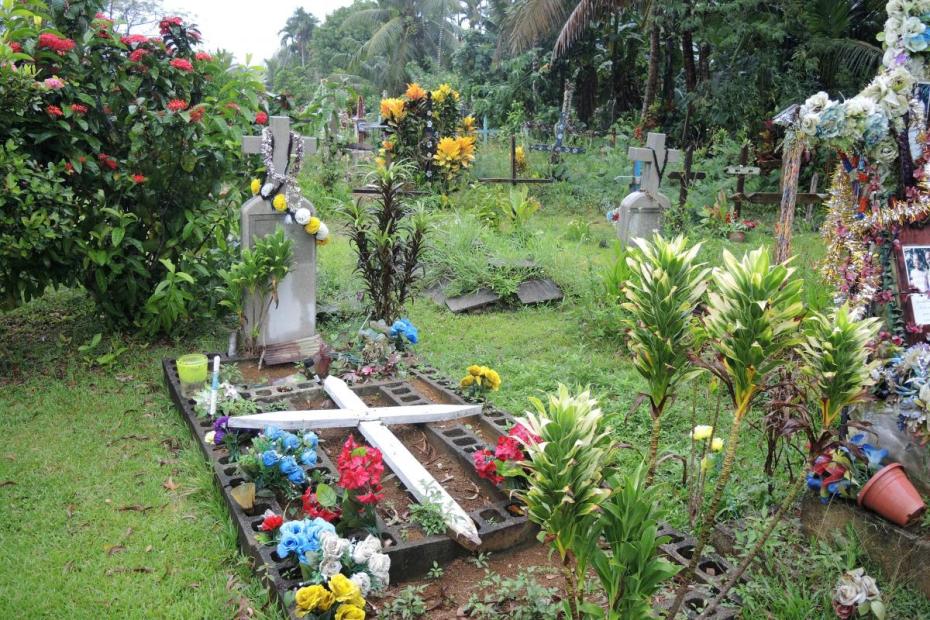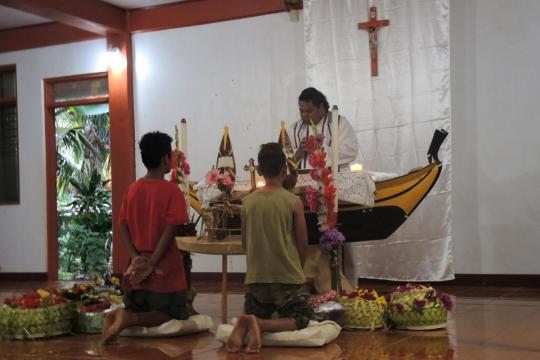Mourning and properly burying the dead—any dead person—is a major community event in Yap. Event is perhaps not the right word, since the process takes many days. Francis Hezel notes, a “funeral is a miracle of rapid organization in a society better known for studied deliberateness in its activities.”1 As other traditions have diminished, he suggests, the funeral has taken on greater significance as a carrier of tradition. Others also suggest, though, that it has been influenced by modern mores, adding more feasting than was once considered proper.2 Either way, people say that it is a grander event today than ever before, building on traditional norms interwoven, for Catholics, with Catholic ones.
When a death occurs, word is spread quickly and large numbers of people converge on family land to prepare things.3 A family is not expected—or often able—to pay all the expenses of death and burial. In the past, food was brought to the compound, but today people have a significant need for cash gifts to pay for hospital bills, the morgue, etc. People still often need to borrow to cover it all, but everyone connected to the family is expected to contribute. To volunteer to help and bring food is described as both a traditional and a Christian duty. The body is usually embalmed before being brought to the home of the person where the mourning ritual takes place, or to a place approved by them—perhaps the nearest relative, if the deceased’s house and yard are not big enough. Relatives, neighbors, pretty much the whole village, helps with any cleaning needed at the house and its yard. Tents are set up outside, including a separate one for men, who have to be separate, it is said, because they do not traditionally participate in the doloolow, the wailing ritual that is the women’s role. At the doloolow, women lie down around the coffin, telling the dead things that they wish they’d said in life. Interviewees said that it entails speaking to the dead, rather than praying to God, but it is considered one of the key rituals of the process. As if to counterbalance that, women said that sometimes tell jokes to lighten things up, but can’t do that if the men are there. (A video of a Good Friday liturgical adaptation of the doloolow for a church setting provides some sense of the type of wailing occurs at the home.)
Family and friends stay up all night, or even for three nights, taking turns staying awake to be with the body. Women traditionally did this, but some men do so today. Though mourning was not traditionally considered masculine, that is changing, so men might come and say goodbye to the body. The family lines up at the body to touch their forehead to show respect, though in recent times some people kiss its hands or head, depending on their role in family.
Men tell their own jokes in their own tent. If people bring beer and betelnuts, the men take what they want, and may give some to the women. Interviewees reported that there used to be more drinking, but now that is declining.
Catholics notify the priest as well, and incorporate Catholic elements into the process. There is a Rosary each morning and evening, and church songs are sung with help from the choir that comes to pray and sing.
After the one- or three-day period of mourning is complete, the priest accompanies the body from the house, blessing it there, to burial. The burial is followed by a novena, nine days’ of evening Rosary prayers—sometimes even by 18 days of Rosaries— before there is finally a funeral at the church. Only a few people ever bring the body into the the church for a funeral before the burial.
The beliefs and practices surrounding death in pre-colonial traditional religion are not entirely clear, but Yapese who were interviewed said that they understood from their parents that in old times, people believed that the soul departed with the person, rather than staying around among them. At funerals, while mourners often still refer to the ancestors (thagiith) of the tabinaew during traditional laments, more and more people ask Got (“God”) to give the blessing to the family in the concluding refrains.
Funerals, as elsewhere, are about mourning and saying goodbye and praying for the dead, but interviewees reported that like everything in Yap they serve a highly valued communal function, as the ritual occasion that forces families to come back together and putting aside differences and coming together in reconciliation. In Yap, all things, including an individual death, are ultimately communal.
- 1Francis X. Hezel, S.J.,The New Shape of Old Island Cultures: A Half Century of Social Change in Micronesia (Honolulu: University of Hawai‘i, 2001), 103-104.
- 2Hezel, The New Shape, 107.
- 3These happenings were readily visible from the road in one instance, but it was not possible to participate directly, so this report relies on descriptions from Yapese interviewees.

